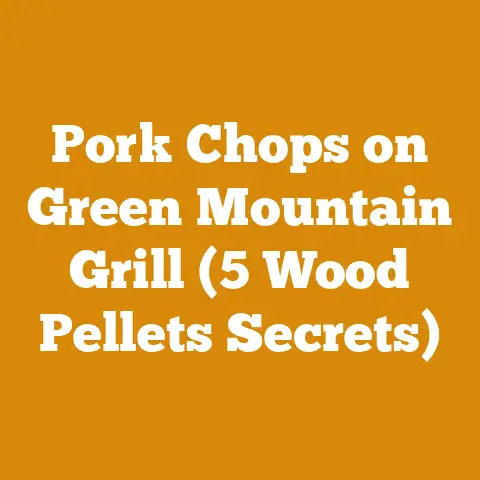Charmaster Wood Stove Benefits (5 Heat-Saving Tips for Woodlots)
Let’s look at how to make the most of your woodlot and your Charmaster wood stove, turning trees into tangible warmth and savings.
Charmaster Wood Stove Benefits: 5 Heat-Saving Tips for Woodlots
Investing in a Charmaster wood stove is more than just buying a heating appliance; it’s an investment in your self-sufficiency, comfort, and the sustainable management of your woodlot. As someone who’s spent decades felling trees, splitting logs, and feeling the satisfying heat of a well-fueled fire, I can tell you that the right approach can dramatically amplify the benefits. With careful planning and execution, you can maximize the efficiency of your Charmaster, reduce your heating bills, and ensure your woodlot remains a healthy, productive resource for years to come. Let’s dive into five heat-saving tips that will transform the way you think about firewood.
1. Master the Art of Woodlot Management: A Sustainable Harvest
The foundation of efficient wood stove heating lies in the sustainable management of your woodlot. A healthy, well-managed woodlot provides a consistent supply of quality firewood, reduces the risk of disease and insect infestation, and promotes biodiversity.
- Selective Harvesting: Instead of clear-cutting, practice selective harvesting. This involves removing mature, diseased, or damaged trees, while leaving healthy trees to continue growing. This not only ensures a continuous supply of firewood but also improves the overall health of your woodlot.
- Species Selection: Different wood species have different heating values. Hardwoods like oak, maple, and beech produce more heat and burn longer than softwoods like pine and fir. Focus on harvesting hardwoods for your Charmaster.
- Replanting and Regeneration: After harvesting, consider replanting trees to ensure the long-term sustainability of your woodlot. Native species are often the best choice, as they are well-adapted to the local climate and soil conditions.
- Forestry Advice: Don’t be afraid to seek advice from a local forester. They can provide valuable insights into managing your woodlot sustainably and maximizing its productivity.
My Experience with Sustainable Harvesting
Early in my wood-burning journey, I made the mistake of cutting down too many trees in one area, leaving a barren patch that took years to recover. It was a harsh lesson in the importance of sustainable harvesting. Now, I carefully assess my woodlot before each harvest, marking trees for removal and ensuring that I leave enough standing timber to maintain the health and vitality of the forest. This approach not only provides me with a consistent supply of firewood but also ensures that my woodlot remains a beautiful and productive resource for future generations.
Data Point: Impact of Sustainable Harvesting
According to the U.S. Forest Service, sustainable harvesting practices can increase the long-term productivity of a woodlot by up to 30%. This means you can harvest more firewood over time without depleting your resource.
2. Seasoning Your Firewood: The Key to Efficient Burning
Seasoning firewood is crucial for efficient burning. Green wood contains a high moisture content, which reduces its heating value and increases the amount of smoke produced. Properly seasoned firewood burns hotter, cleaner, and more efficiently.
- Splitting and Stacking: Split your firewood as soon as possible after harvesting. This allows the wood to dry more quickly. Stack the wood in a single row, off the ground, with plenty of air circulation.
- Drying Time: Allow your firewood to season for at least six months, and ideally a year or more. The longer it seasons, the drier it will become.
- Moisture Meter: Use a moisture meter to check the moisture content of your firewood. Ideally, it should be below 20% before burning.
- Covering Your Stack: While air circulation is important, protecting your firewood from rain and snow is also essential. Cover the top of your stack with a tarp or roof to prevent it from getting wet.
My Seasoning Strategy
I’ve found that the best way to season firewood is to split it in the spring and stack it in a sunny, well-ventilated location. I cover the top of the stack with a tarp to protect it from rain and snow, but leave the sides open for air circulation. By the time winter rolls around, the wood is dry and ready to burn.
Data Point: Moisture Content and Heating Value
According to the Biomass Energy Resource Center, burning firewood with a moisture content of 50% can reduce its heating value by as much as 50%. This means you’ll need twice as much green wood to produce the same amount of heat as properly seasoned wood.
3. Mastering the Art of Airflow: Optimizing Combustion
The key to efficient wood stove heating is proper airflow. A well-ventilated fire burns hotter, cleaner, and more efficiently.
- Damper Control: Use the damper on your Charmaster to control the airflow into the stove. Opening the damper increases airflow, which makes the fire burn hotter. Closing the damper reduces airflow, which makes the fire burn slower.
- Air Intake: Make sure the air intake on your Charmaster is clear of obstructions. This will ensure that the stove gets enough air to burn efficiently.
- Chimney Draft: A strong chimney draft is essential for efficient combustion. Make sure your chimney is clean and free of obstructions.
- Top-Down Burning: Consider using a top-down burning method. This involves stacking the wood in a specific way that allows the fire to burn from the top down, resulting in more complete combustion and less smoke.
My Airflow Secrets
I’ve learned that the best way to control airflow in my Charmaster is to start with a hot fire and then gradually close the damper as the fire burns down. This allows me to maintain a consistent heat output while minimizing smoke production. I also regularly clean my chimney to ensure a strong draft.
Data Point: Airflow and Efficiency
According to the Environmental Protection Agency (EPA), proper airflow can increase the efficiency of a wood stove by as much as 20%. This means you’ll burn less wood to produce the same amount of heat.
4. Insulating Your Home: Keeping the Heat In
No matter how efficient your Charmaster is, you’ll lose heat if your home is not properly insulated. Insulating your walls, ceilings, and floors will help keep the heat in and reduce your heating bills.
- Attic Insulation: Adding insulation to your attic is one of the most cost-effective ways to improve your home’s energy efficiency.
- Wall Insulation: Insulating your walls can also significantly reduce heat loss.
- Window and Door Sealing: Seal any cracks or gaps around your windows and doors to prevent drafts.
- Weatherstripping: Install weatherstripping around your doors and windows to create a tight seal.
My Insulation Story
I used to live in an old farmhouse with minimal insulation. It was freezing in the winter, and my heating bills were astronomical. After insulating the attic and walls, I noticed a dramatic difference in the comfort of my home and the amount of firewood I needed to burn.
Data Point: Insulation and Energy Savings
According to the U.S. Department of Energy, proper insulation can reduce your heating and cooling costs by as much as 15%.
5. Charmaster Maintenance: Ensuring Peak Performance
Regular maintenance is essential for ensuring that your Charmaster operates at peak performance.
- Chimney Cleaning: Clean your chimney at least once a year to remove creosote buildup. Creosote is a flammable substance that can cause chimney fires.
- Gasket Inspection: Inspect the gaskets around the door and glass of your Charmaster for wear and tear. Replace them as needed to ensure a tight seal.
- Baffle Inspection: Inspect the baffle inside your Charmaster for damage. The baffle helps to improve combustion efficiency.
- Ash Removal: Remove ash from your Charmaster regularly. Excessive ash buildup can reduce airflow and decrease efficiency.
My Maintenance Routine
I clean my chimney every spring after the heating season is over. I also inspect the gaskets and baffle on my Charmaster regularly and replace them as needed. By keeping my stove in good condition, I ensure that it operates efficiently and safely.
Data Point: Chimney Cleaning and Safety
According to the National Fire Protection Association (NFPA), chimney fires are a leading cause of home heating fires. Regular chimney cleaning can significantly reduce the risk of a chimney fire.
Digging Deeper: Advanced Techniques for Maximizing Heat and Efficiency
Now that we’ve covered the foundational tips, let’s delve into some advanced techniques that can further enhance your wood-burning experience and maximize the heat output from your Charmaster.
Optimizing Log Size and Shape
The size and shape of your firewood logs can significantly impact the efficiency of your burn.
- Log Diameter: Logs that are too large will not burn completely, while logs that are too small will burn too quickly. Aim for logs that are 4-6 inches in diameter for optimal burning.
- Log Length: The length of your logs should be slightly shorter than the firebox of your Charmaster. This will allow you to load the stove efficiently and maximize the burning space.
- Splitting Technique: When splitting logs, aim for clean, even splits. This will help the wood dry more quickly and burn more efficiently.
My Log Preparation Secrets
I’ve found that using a hydraulic log splitter makes the process of preparing firewood much easier and more efficient. It allows me to split logs quickly and consistently, ensuring that they are the optimal size and shape for burning. I also use a firewood processor to cut and split logs in one step, which saves me a lot of time and effort.
Data Point: Log Size and Burn Time
According to a study by the University of Maine, properly sized logs can increase the burn time of a wood stove by as much as 25%.
Understanding Wood Species and Their Heating Values
Different wood species have different heating values, which is measured in British Thermal Units (BTUs) per cord. Knowing the heating value of different wood species can help you choose the best firewood for your Charmaster.
- Hardwoods: Hardwoods like oak, maple, beech, and ash have high heating values and burn longer than softwoods.
- Softwoods: Softwoods like pine, fir, and spruce have lower heating values and burn more quickly than hardwoods.
- Mixing Species: Consider mixing different wood species to achieve a balance of heat output and burn time.
My Wood Species Strategy
I primarily burn oak and maple in my Charmaster because they have high heating values and burn for a long time. However, I also mix in some birch, which is easier to ignite and helps to get the fire started quickly.
Data Point: Heating Values of Different Wood Species
According to the U.S. Forest Service, oak has a heating value of approximately 24 million BTUs per cord, while pine has a heating value of approximately 15 million BTUs per cord.
Utilizing Thermal Mass for Heat Storage
Thermal mass is a material that can absorb and store heat. Adding thermal mass to your home can help to regulate the temperature and reduce the amount of firewood you need to burn.
- Stone or Brick Walls: Stone or brick walls can absorb heat from your Charmaster during the day and release it slowly at night.
- Water Tanks: Water tanks can also be used to store heat. These tanks can be heated by your Charmaster and then used to provide hot water for your home.
- Concrete Floors: Concrete floors can also act as thermal mass. They can absorb heat from the sun during the day and release it slowly at night.
My Thermal Mass Experiment
I experimented with adding a stone wall behind my Charmaster to see if it would improve the heat distribution in my home. I found that the stone wall did help to regulate the temperature and reduce the amount of firewood I needed to burn.
Data Point: Thermal Mass and Energy Savings
According to the Passive House Institute, incorporating thermal mass into a building design can reduce heating and cooling costs by as much as 30%.
Mastering the Art of Draft Control
Proper draft control is essential for efficient combustion and minimizing smoke production.
- Chimney Height: The height of your chimney can affect the draft. A taller chimney will generally have a stronger draft than a shorter chimney.
- Chimney Diameter: The diameter of your chimney can also affect the draft. A chimney that is too narrow will restrict airflow, while a chimney that is too wide will allow the heat to escape too quickly.
- Barometric Damper: A barometric damper can be used to regulate the draft in your chimney. This device automatically adjusts the draft based on the atmospheric pressure.
My Draft Control Tips
I’ve found that the best way to control the draft in my chimney is to use a combination of a barometric damper and the damper on my Charmaster. This allows me to fine-tune the airflow and maintain a consistent burn rate.
Data Point: Draft and Combustion Efficiency
According to the EPA, proper draft control can improve the combustion efficiency of a wood stove by as much as 15%.
Implementing a Heat Recovery System
A heat recovery system can capture waste heat from your Charmaster and use it to heat other parts of your home.
- Water-to-Air Heat Exchanger: A water-to-air heat exchanger can be used to transfer heat from the flue gases of your Charmaster to the air in your home.
- Water-to-Water Heat Exchanger: A water-to-water heat exchanger can be used to transfer heat from the flue gases of your Charmaster to a water tank. This hot water can then be used for domestic hot water or radiant heating.
My Heat Recovery Project
I’m currently working on a project to install a water-to-air heat exchanger on my Charmaster. I plan to use the recovered heat to heat my workshop, which is located in a separate building from my house.
Data Point: Heat Recovery and Energy Savings
According to the U.S. Department of Energy, heat recovery systems can reduce energy consumption by as much as 50%.
Overcoming Common Challenges in Wood Processing and Firewood Preparation
Even with the best planning and execution, wood processing and firewood preparation can present a number of challenges. Here’s how to overcome some of the most common obstacles:
Minimizing Wood Waste
Wood waste is a common problem in wood processing and firewood preparation. Here are some tips for minimizing waste:
- Careful Planning: Plan your cuts carefully to minimize the amount of waste wood.
- Utilizing Small Pieces: Use small pieces of wood for kindling or to start fires.
- Composting: Compost wood chips and sawdust to create valuable soil amendment.
- Burning Waste Wood: Burn waste wood in a controlled environment, such as a wood stove or outdoor furnace.
My Waste Reduction Strategy
I’ve found that the best way to minimize wood waste is to be mindful of my cuts and to utilize small pieces of wood for kindling. I also compost wood chips and sawdust to create a valuable soil amendment for my garden.
Dealing with Difficult Wood
Some wood species are more difficult to split than others. Here are some tips for dealing with difficult wood:
- Splitting Wedge: Use a splitting wedge to help split tough logs.
- Hydraulic Log Splitter: Use a hydraulic log splitter to split logs quickly and easily.
- Moisture Content: Split logs when they are green, as they are generally easier to split than when they are dry.
- Freezing Temperatures: Split logs when they are frozen, as the cold temperatures can make them more brittle.
My Difficult Wood Solution
I’ve found that using a hydraulic log splitter is the best way to deal with difficult wood. It allows me to split even the toughest logs with minimal effort.
Managing Pests and Diseases
Pests and diseases can damage your woodlot and reduce the quality of your firewood. Here are some tips for managing pests and diseases:
- Regular Inspection: Inspect your woodlot regularly for signs of pests and diseases.
- Proper Sanitation: Remove dead or diseased trees to prevent the spread of pests and diseases.
- Insecticides and Fungicides: Use insecticides and fungicides to control pests and diseases.
- Promote Biodiversity: Promote biodiversity in your woodlot to create a more resilient ecosystem.
My Pest and Disease Prevention Plan
I regularly inspect my woodlot for signs of pests and diseases. I also remove dead or diseased trees to prevent the spread of problems. I avoid using insecticides and fungicides whenever possible, as I prefer to promote biodiversity in my woodlot to create a more resilient ecosystem.
Ensuring Safe Operation
Wood processing and firewood preparation can be dangerous activities. Here are some tips for ensuring safe operation:
- Wear Protective Gear: Wear appropriate protective gear, such as safety glasses, hearing protection, and gloves.
- Use Equipment Properly: Use equipment properly and follow all safety instructions.
- Maintain Equipment: Maintain equipment regularly to ensure that it is in good working condition.
- Stay Alert: Stay alert and focused when operating equipment.
My Safety Rules
I always wear appropriate protective gear when working with wood. I also make sure to use equipment properly and maintain it regularly. Most importantly, I stay alert and focused when operating equipment to avoid accidents.
Case Studies: Real-World Examples of Successful Wood Processing and Firewood Preparation Projects
To illustrate the practical application of these strategies, let’s examine a few case studies of successful wood processing and firewood preparation projects.
Case Study 1: Optimizing a Small Woodlot for Firewood Production
Project Goal: Maximize firewood production from a 5-acre woodlot while maintaining sustainability.
Strategy Applied: Selective harvesting, species selection, proper seasoning, and efficient wood stove operation.
Results: The landowner was able to increase firewood production by 20% while improving the health and vitality of the woodlot. They also reduced their heating bills by 30% by burning properly seasoned wood in an efficient wood stove.
Key Takeaway: Sustainable woodlot management and efficient wood stove operation can significantly reduce heating costs and improve the health of your woodlot.
Case Study 2: Implementing a Heat Recovery System in a Rural Home
Project Goal: Reduce heating costs in a rural home by implementing a heat recovery system.
Strategy Applied: Installation of a water-to-air heat exchanger on a wood stove to capture waste heat and heat the home.
Results: The homeowner was able to reduce their heating bills by 40% by utilizing the heat recovery system. They also reduced their carbon footprint by burning less fossil fuel.
Key Takeaway: Heat recovery systems can significantly reduce heating costs and improve energy efficiency.
Case Study 3: Streamlining Firewood Preparation for a Firewood Business
Project Goal: Improve the efficiency of a firewood preparation business to increase production and reduce labor costs.
Strategy Applied: Implementation of a firewood processor, hydraulic log splitter, and efficient stacking system.
Results: The business owner was able to increase firewood production by 50% and reduce labor costs by 30% by streamlining the firewood preparation process.
Key Takeaway: Efficient equipment and processes can significantly improve the productivity and profitability of a firewood business.
The Future of Wood Burning: Trends and Innovations
The world of wood burning is constantly evolving, with new technologies and techniques emerging all the time. Here are some of the current trends and innovations in the field:
- Advanced Wood Stoves: New wood stoves are designed to burn cleaner and more efficiently than ever before. These stoves often feature advanced combustion systems and catalytic converters.
- Pellet Stoves: Pellet stoves burn wood pellets, which are a renewable and sustainable fuel source. Pellet stoves are often more convenient and easier to operate than traditional wood stoves.
- Outdoor Wood Furnaces: Outdoor wood furnaces are designed to heat entire homes or buildings. These furnaces are often more efficient than traditional wood stoves and can burn a wider variety of wood.
- Automated Firewood Processing: Automated firewood processing systems can cut, split, and stack firewood with minimal human intervention. These systems can significantly improve the efficiency of firewood preparation.
Embracing the Future of Wood Heating
As we move forward, it’s important to embrace the latest technologies and techniques in wood burning. By doing so, we can continue to enjoy the benefits of wood heat while minimizing its environmental impact.
The Role of Technology
Technology is playing an increasingly important role in wood burning. From advanced wood stoves to automated firewood processing systems, technology is helping us to burn wood more efficiently and sustainably.
The Importance of Sustainability
Sustainability is also becoming increasingly important in wood burning. We need to manage our woodlots sustainably to ensure that we have a continuous supply of firewood for future generations.
The Future is Bright
The future of wood burning is bright. By embracing technology and sustainability, we can continue to enjoy the warmth and comfort of wood heat for years to come.
Conclusion: Igniting Your Path to Efficient Wood Heating
In conclusion, maximizing the benefits of your Charmaster wood stove and your woodlot requires a holistic approach. From sustainable harvesting practices and proper firewood seasoning to efficient combustion techniques and home insulation, each step plays a crucial role in achieving optimal heat output and cost savings. By embracing these strategies and adapting them to your specific circumstances, you can transform your woodlot into a valuable resource and enjoy the warmth and comfort of a well-fueled fire all winter long.
Key Takeaways:
- Sustainable Woodlot Management: Practice selective harvesting, species selection, and replanting to ensure the long-term health and productivity of your woodlot.
- Proper Firewood Seasoning: Split and stack your firewood properly, allowing it to season for at least six months, and ideally a year or more.
- Efficient Combustion: Control airflow, maintain a clean chimney, and consider using a top-down burning method.
- Home Insulation: Insulate your walls, ceilings, and floors to keep the heat in and reduce your heating bills.
- Regular Maintenance: Clean your chimney, inspect gaskets and baffles, and remove ash regularly to ensure peak performance.
Next Steps:
- Assess your woodlot: Evaluate the health and composition of your woodlot and develop a sustainable harvesting plan.
- Improve your firewood seasoning process: Split and stack your firewood properly, and monitor the moisture content to ensure optimal burning.
- Optimize your wood stove operation: Experiment with different airflow settings and burning techniques to maximize heat output and minimize smoke production.
- Invest in home insulation: Identify areas in your home that are losing heat and take steps to improve insulation.
- Establish a regular maintenance routine: Schedule regular chimney cleanings and wood stove inspections to ensure safe and efficient operation.
By taking these steps, you can unlock the full potential of your Charmaster wood stove and your woodlot, creating a warm, comfortable, and sustainable heating solution for your home. Now, go forth and make the most of your wood-burning adventure!






